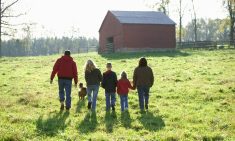If you don’t have people, you don’t have a farm. It’s as simple as that.
While most producers think about their farm in terms of their livestock and crops, they neglect to think about the people, says a rural business specialist with Alberta Agriculture and Forestry.
But that needs to change, Abby Verstraete told attendees at the recent Grazing School for Women.

“Human resources will become a bigger issue in farming as farms get bigger and employment becomes more of an issue,” she said. “People don’t look at human resources as something they can manage and save costs on, but you really can see direct returns if you spend time in that area.”
Start by thinking about the long-term goals for your operation, she said.
“Think about the bigger picture and how human resources will fit into your farm’s strategic plan and your business planning. It should also fit with your philosophy and your goals.”
Then define the roles and responsibilities for everyone on the farm, whether they are employees or family.
“I would emphasize that it’s just as important to have good management practices with family because you are less likely to communicate well with them,” said Verstraete. “You are more likely to make assumptions that they will know what you are talking about, and assumptions that they know what roles or responsibilities you want them to take.”
Read Also

What to consider when setting up farm-related business ventures
Things to consider before launching a farm-adjacent side business.
Miscommunication comes with a big cost if it results in stressed animals, broken equipment, or lost productivity. It’s key to have clearly defined expectations for every worker and clear lines of authority, she said.
Employers should also continually assess their labour needs and see how those needs line up with their current work force.
“If they don’t match, sometimes it’s as easy as looking at job descriptions and moving around responsibilities with people who are on the farm,” said Verstraete.
Job descriptions pinpoint responsibilities and determine what each team member has to do.
“These are also good for succession. People can see who is doing what, and it’s formal and written down.”
Compensation is tricky and Verstraete’s advice was to talk to other employers, look at job postings to see what employers in your area are offering, and use online resources. (One she recommended was the agri-talent section of the Canadian Agricultural Human Resources Council website — which lists agricultural jobs across the country.)
When writing a job description, make sure it’s accurate.
“It’s an agreement on both sides,” she said. “They want to know what they’re stepping into and you want to know that they can handle it.”
Consider offering benefits, as well as things such as specialized training or mentorship, to make yourself a more attractive employer.
“Often people working in the agriculture industry are looking beyond compensation, and are looking for training or mentorship,” said Verstraete. “This is what keeps them engaged and passionate. They’re going to keep learning in the industry and be able to develop. It’s a human need to feel that you are continually growing.”
Communication is the key, she added.
“People should know what is expected of them at work. This sounds like the easiest thing ever, but it can be very complex and can get confusing.”
Additional HR online resources
Farm Management Canada has articles, books, and other tools at fmc-gac.com.
Manitoba’s Agriculture Department has a free online publication called Human Resource Management for Agriculture Organizations that can be found at the Manitoba Agriculture website (search for “human resource management”).
This article first appeared in the July 4 issue of the Alberta Farmer Express.
















